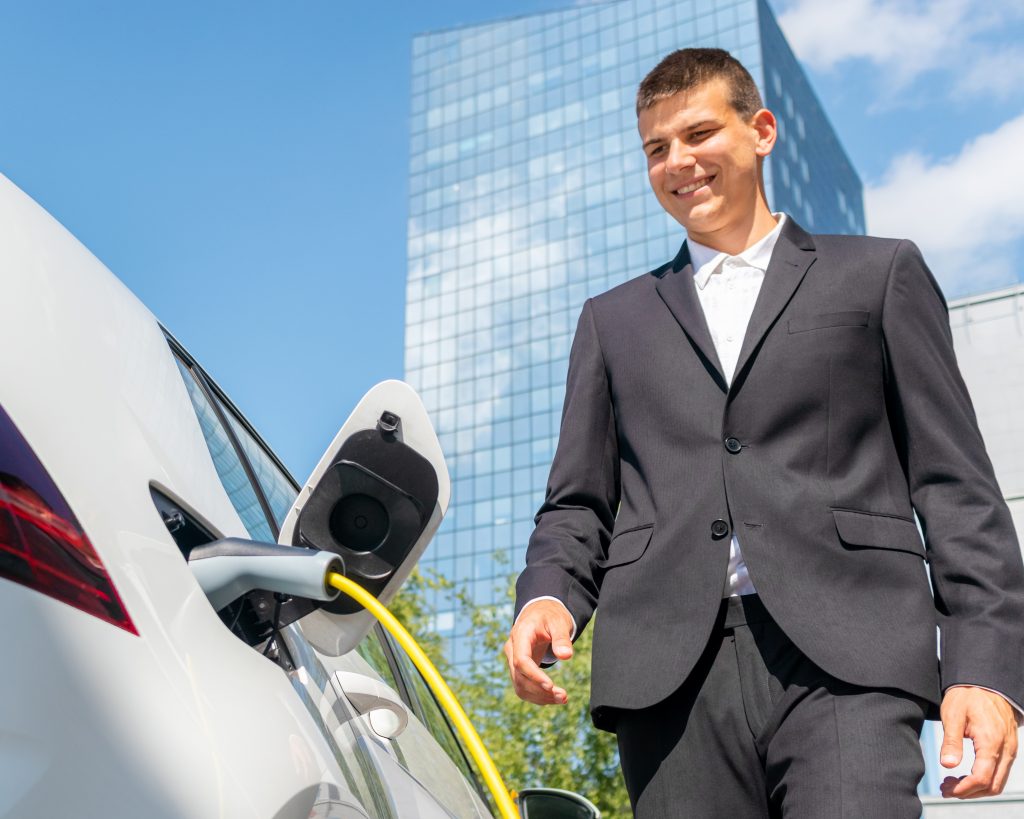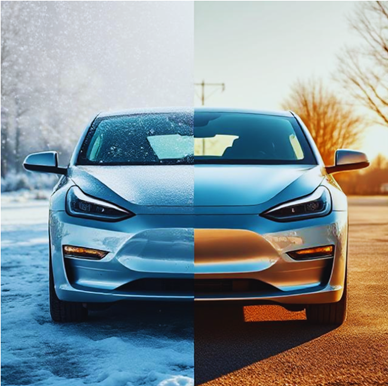Charging Basics
Learn the fundamentals of EV charging, including types of chargers, installation tips, and how to maximize your electric vehicle’s range for a seamless driving experience.
Charging Stations
With the increased demand of EVs, charging is a crucial component to consider. As seen above, one station can have multiple ports and connectors. Charging stations are being installed in key locations throughout the country for public charging and workplace charging as a supplement to residential charging. Most EV owners do the majority of their charging at home.


Oklahoma Charging Infrastructure
Oklahoma continues to expand its public EV charging network to support drivers statewide. With hundreds of publicly accessible stations and thousands of ports available, EV users have a growing number of options for recharging across urban and rural areas.
Charging Levels + Speeds
While charging an EV there are a few factors to consider such as the charging speed, the battery’s state of charge, the battery’s capacity, temperature, and the level of charging equipment. There are currently three different speeds of chargers, level 1, level 2, and direct-current fast charging (DC fast charging).

Level 1
This common charger can be plugged into the average (120-Volt) AC outlet inside your home. 40-50+ hours to charge a BEV from empty to 80% and 5-6 hours for a PHEV.
Level 2
Level 2 chargers provide faster charging time however require a (240-Volt) AC outlet for residential and a (208-Volt) for commercial use. For residential houses, the majority will require an installation of a (240-Volt) AC outlet. Level 2 chargers can charge a BEV from empty to 80% in 4-10 hours and a PHEV in 1-2 hours. These chargers can additionally be found in public locations such as grocery stores and malls.
Level 3
Direct Current Fast Charging (DC Fast Charging)
DC fast charging provides rapid charging with (480-volt). A DC charger can charge a BEV from empty to 80% in just 20 minutes to 1 hour. The majority of PHEVs on the market are not compatible with DC chargers. Although it is more convenient, it is advised to not use DC chargers too often as it will degrade the battery health and lifespan. DC chargers are often utilized during long road trips.
WORKPLACE CHARGING
Workplace charging for EVs provides employees with convenient access to charging stations during the workday, encouraging responsible energy use and reducing range anxiety. Businesses that provide this convenient benefit can attract and retain workers. Emphasizing private-sector solutions and cost-effective sustainability, workplace EV charging can be a smart choice for Oklahoma businesses. For more information, visit EMPOWER.

Winter vs Summer Preparations
EVs are designed to perform year-round, but extreme temperatures—whether cold or hot—can affect battery performance, charging times, and overall range. Understanding how seasonal weather impacts your EV and taking simple steps to prepare can help ensure efficient, reliable operation whether you’re navigating icy roads or summer heat.

Winter EV Prep
Winter weather can affect any vehicle, so understanding how it impacts your electric vehicle is essential for ensuring it runs smoothly and efficiently.
How Cold Temperatures Affect the Battery
When outside temperatures hit 32 degrees Fahrenheit or freezing, the chemical reaction that generates electricity slows down. The battery has to be warm enough to allow the electrons to move and charge the battery. In particular direct-current charging (DC) stations require the battery to be at higher temperatures before charging can begin, indicating that it is not wise to always use DC charging in colder months as it degrades the battery at a faster rate.

Solutions and Preparations
The primary reason it takes longer to charge electric vehicles in winter is because the battery gets cold at lower temperatures. When a driver connects their vehicle to a charger, the battery often requires 30 to 45 minutes to warm the battery, then the battery will begin charging. However, once the battery reaches the appropriate temperature, normal charging speeds will resume.
To avoid excess charging time, the driver should drive 15-20 minutes to a charging station. This allows the battery to warm-up at a faster rate due to driving processes, rather than using a charger to warm the battery. This solution also saves consumers money as you are not paying for additional power to warm up the battery.
“Most EVs are programmed to warm the battery if the driver tells the vehicle’s navigation system that a trip to the charging station is coming.”
Tips for Winter Weather
Find a charging station 25-30 miles away, the battery will start to warm up during the drive there.
Preheating your vehicle while it’s still plugged in can save EV battery capacity because the energy for heating comes from the grid, not the battery (residential chargers)
Use seat warmers, a heated steering wheel and turn down the cabin heater. These features use less energy and provide targeted heat, saving battery life.
Tesla Manual says thaw the ice on the latch by enabling the “Defrost Car” setting on the mobile app
Plan and expect that charging in freezing temperatures will require additional time, anywhere from 45 min-1 hour
Summer EV Preparations
The battery and range capacity for EVs can decrease due to higher temperatures, however the loss of range in summer is much lower than a driver may experience in the winter. Understanding how weather impacts your vehicle and knowing how to prepare is key to running your vehicle smoothly.
How Hot Temperatures Affect the Battery
When outside temperatures reach hot temperatures, the battery’s internal temperature also rises, causing the chemical reactions that generate electricity to slow down slightly. Range loss is typically reported at 95-100 degrees fahrenheit.

Tips for Summer Weather
Charge your EV during cooler parts of the day, like early morning or late evening, to avoid stressing the battery.
Plan your routes ahead. Consider your driving routes and times and avoid peak heat hours to improve efficiency and comfort.
Check tire pressure regularly, as heat can cause it to increase.
Make sure your vehicle’s software is up to date. Manufacturers often release updates that can improve battery management & efficiency.
Whenever possible, park in shaded areas or use sunshades to reduce interior temperatures, which can help protect the battery from excessive heat.
Understanding the Battery
How It Works
An electric vehicle battery, also known as a lithium-ion battery, is like a big pack of small cells filled with special liquids. Each cell has three main parts:
Negative Electrode (Anode)
This is the part that receives electrons (like a sponge absorbs water).
Positive Electrode (Cathode)
This is the part that releases electrons (like a sponge releases water).
Positive Electrode (Cathode)
This is a special liquid that helps the electrons move between the two electrodes.
When you plug in the car to charge it, electricity from the power source (like a wall charger or a charging station) flows into the battery. This electricity makes the negative electrode (anode) absorb electrons, which makes it negative.
At the same time, the positive electrode (cathode) releases electrons, which makes it positive. The electrolyte helps these electrons move from one electrode to the other, creating an electric current.

The Future of EV Batteries
As the world shifts towards sustainable energy solutions, the EV battery industry has emerged as a pivotal force driving this transformation. The growing demand of electric vehicles and concerns such as range anxiety and battery efficiency have propelled automotive engineers across the world to focus their efforts on extensive battery technological advances. Currently, lithium-ion batteries dominate the EV market, however new technologies are emerging that express a promising future for electric vehicles and their efficiencies.

A prime example of EV technology is the advancement of heat pump systems.
Automotive engineers have invented heat pump systems that significantly increase energy efficiency. The main advantage of a heat pump lies in its effective use of power; employing an AC compressor that draws between 1,000 to 3,000 watts, compared to the traditional PTC heaters, which can consume up to 7,500 watts. This translates to substantial energy savings. This innovative system eliminates the need for additional components. The integration of heat pumps not only simplifies the build process, making it more cost-effective to manufacture, but also increases longevity and reliability of the vehicle, as there are fewer parts that degrade or need replaced. Electric Vehicles are the product of the intersection between innovation and American power.
Consumers have reported seeing their battery charge last longer with the heating pump, meaning the battery can operate at a more efficient rate.
“After three hours of heating the cabin, both vehicles showed a drop in the state of charge, of course. However, the differences in the drop were night and day. The heat pump-equipped 2021 Model 3 had dropped only 3% in the three-hour span, while the sedan’s pre-heat pump variant had lost 10% of its battery.”
Sourced: Professor John D. Kelly at Weber State University -Automotive Technology Department-Advanced Vehicles Lab. (May 2023)
Tesla’s Innovative And Efficient Heat Pump Explained In New Video (insideevs.com)
https://www.teslarati.com/tesla-model-3-heat-pump-test-video/
Wray, A.; Ebrahimi, K. Octovalve Thermal Management Control for Electric Vehicle. Energies 2022, 15, 6118.

